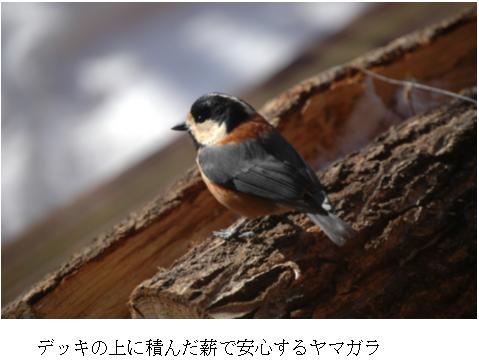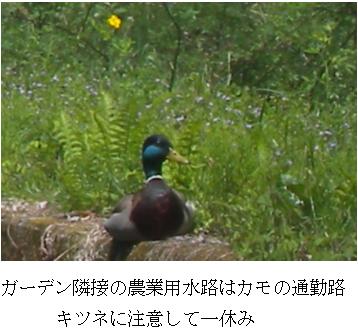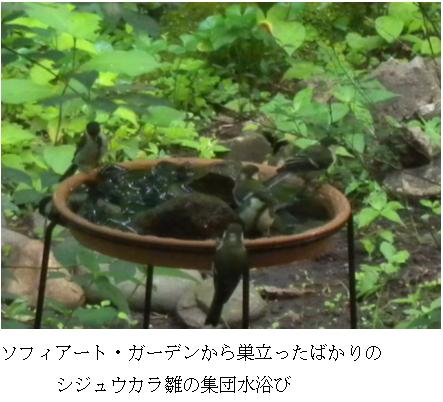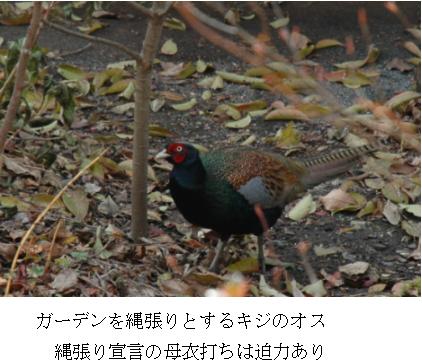「安心できる木」とは何か、という問いに対して、ヒトはどのような答えを想像するでしょうか。
「金のなる木」なんて想像したヒトは、お金が大好きなのでしょう。大きな木陰を作る木を想像したヒトは、緑陰の下で安らぐ心地よさが好きなのでしょう。その人の好みによって「安心できる木」のイメージも変わってくると思います。

さて、ソフィアート・ガーデンにおいては、野鳥たちが魅力を感じていつも遊びに来てくれることを最優先に目指しておりますので、ここでいう「安心できる木」とは、小鳥たちにとって、という視点から考えております。
野鳥、特に小鳥たちは、常に危険な捕食者(猛禽類やヘビ、キツネ、ネコ、ヒト?など)に狙われています。彼らは全身がすばらしいセンサーのように反応し危機や変化に敏感です。目が顔の横についているので視野が広く、後ろでこちらがほんの少し動いてもさっと飛び去ります。そんな彼らに、少しでも安心して喜んでもらうためには、どうしたらいいのでしょうか。
まずは、小鳥たちが危険を感じたときにすぐに飛び込めるような、捕食者から手の届かない(あるいは見えにくい)シェルターのような場所をつくってみよう、と私どもは考えました。

ところで、小鳥たちは、羽毛を大事に手入れするために頻繁に水浴びしますので、ソフィアート・ガーデンには水場を複数つくってあります。水浴びは頭を水につけるので、鳥たちにとってはとても無防備な瞬間となります。そこで、いかに安心して水浴びできる環境にするかが、小鳥たちに気に入ってもらうためのポイントになります。
ガーデンではいずれも水場の傍には、鳥が止まりやすい太さの横枝が張った中高木(エゴノキ、ハクウンボク、ソヨゴ)や、少し枝の込み入った低木の常緑樹(イチイ、アズマシャクナゲ、ヤクシマシャクナゲ、ホンギリシマ)、同様に細やかな枝が風情ある茂みになる落葉樹や半落葉樹(ユキヤナギ、ヤマブキ、クロモジ、ヤマツツジ、ミツバツツジ、エゾムラサキツツジなど)を植えています。
常緑樹は、高い上空からは見通しが利かないので、小鳥たちにとってはカラスや鷹などから隠れるシェルターにもなります。

こうした木々に止まって周囲の様子をうかがい安全を確認すると、心から嬉しそうに水浴びを始めます。水場は大人気ですので、たいてい一羽が行くと、みんな「私も!私も!」と何羽も集まりますが、止まり木のように横枝の張った木は、人気店の順番待ちのベンチのように賑わいます。そして水浴びの終わった鳥は、それぞれがお気に入りの枝にさっと移動し、優雅に羽繕いをします。なかにはアクビや居眠りする小鳥までいます。なお、なるべく水場は少し高めに配置しておき、ネコなどのハンターの隠れ場所がないようにしておくのも、小鳥たちの安心のためには重要です。

またノイバラのような人間にとっては痛い棘のある木も、小鳥にとっては逆にその棘が守ってくれるため安心できる木になります。ガーデンの一角に野生のラズベリーともいえるクマイチゴがたくさん自生していますが、ここはウグイスの格好の隠れ場で、早春にはこの有刺鉄線のような茂みの中で「ホー、ホキョ・・・」と未熟なさえずりを小声でつぶやき、練習に励む様子が見られます。
ところで、野鳥に遊びに来て欲しいのならば、バラなどの栽培にありがちな薬剤の散布は厳禁です。なにしろ、薬剤の目的である殺虫は、羽のある友人の大事な糧に毒を盛るようなことになります。そしてなにより鳥がくつろいで遊んでくれる木は、鳥がせっせと虫を食べてくれるので「害虫」というものがいません。「元気で、薬いらず」です。
私ども人間が家で安らぐと元気を回復し、明日もハツラツと頑張れるように、野鳥にとっての家である木も、彼らが心から安心できる木であって欲しいと願っています。
『 ソフィアート・ガーデン物語 』 第1話 「安心できる木」
有限会社ソフィアート スタッフM( 竺原 みき )
The Tale of Sophiart Garden
>>To the Previous Story | >>To the Next Story
Chapter 1
“A Tree of Comfort”
April 10, 2012
What comes to mind when you hear the phrase “a tree of comfort”?
For some, it may conjure the image of a “money tree,” revealing a deep fondness for wealth. Others might imagine a grand tree with a broad canopy, offering the soothing embrace of cool shade. The idea of a tree of comfort likely differs from person to person, shaped by individual inclinations and values.
A Tree of Comfort—From a Bird’s Perspective
At Sophiart Garden, our foremost priority is to create an environment so enticing that wild birds feel drawn to visit time and again. With this in mind, our concept of a tree of comfort is viewed through the lens of the birds themselves.
For small birds, life is a constant battle against formidable predators—raptors, snakes, foxes, cats, and even humans. Their senses are extraordinarily sharp, ever attuned to the subtlest shifts in their surroundings. With their eyes positioned on the sides of their heads, their field of vision is vast. A mere movement behind them, however slight, will send them darting away in an instant.
So, what can we do to help these little visitors feel at ease and truly enjoy their time here?
We decided to create a sanctuary—a place where small birds can take refuge from predators, where danger is obscured from sight or kept at a safe distance.
The Role of Water and Shelter
Birds take great care in maintaining their feathers, and bathing is an essential part of their routine. At Sophiart Garden, we have created multiple water sources to accommodate this natural behavior. However, when birds bathe, they momentarily let their guard down—their heads dip into the water, rendering them vulnerable.
Thus, ensuring a safe and secure bathing environment is crucial to gaining their trust.
To this end, we have carefully positioned various trees and shrubs near the water sources:
• Mid-sized trees with sturdy, horizontally extending branches (such as Styrax japonicus, Euscaphis japonica, and Ilex sugerokii), providing ideal perches.
• Dense, evergreen shrubs (Taxus cuspidata, Rhododendron degronianum var. amagianum, Rhododendron yakushimanum, and Ilex crenata), offering a protective thicket.
• Deciduous and semi-evergreen trees with delicate branching patterns, forming elegant groves (Spiraea thunbergii, Kerria japonica, Lindera umbellata, Rhododendron kaempferi, Rhododendron dilatatum, and Rhododendron dauricum).
Evergreens, in particular, serve as excellent shelters, concealing small birds from sharp-eyed predators like crows and hawks soaring above.
Perched among these branches, birds carefully survey their surroundings. Once they feel safe, they begin to bathe—joyfully and without reserve.
Water sources are immensely popular. When one bird takes the plunge, others soon follow, as if exclaiming, “Me too! Me too!” The trees around the water become lively gathering spots, resembling the waiting benches at a bustling café.
After their baths, the birds swiftly retreat to their favorite perches, where they groom themselves with quiet elegance. Some even yawn or drift into a drowsy repose.
To further enhance their sense of security, we ensure that the water sources are slightly elevated and free from potential hiding spots for stealthy hunters like cats.
Thorns—A Hidden Sanctuary
While thorny plants like Rosa multiflora may seem troublesome to humans, they are a source of comfort and safety for small birds.
In one corner of Sophiart Garden, wild raspberries (Rubus trifidus) grow in abundance. These brambles have become a beloved sanctuary for nightingales. In early spring, hidden within the tangle of thorny branches, young nightingales can be heard softly practicing their song—tentative whispers of “Hoo… Hoke-yo…” as they refine their melodies.
If one wishes to invite wild birds into a garden, the use of pesticides is strictly forbidden. Pesticides, after all, are designed to kill insects—the very lifeblood of our feathered friends.
Interestingly, trees frequented by birds rarely suffer from so-called “pests,” as the birds diligently keep the ecosystem in balance. A thriving, bird-friendly garden requires no chemical intervention—it flourishes naturally, full of life and vitality.
A Home for Birds, A Sanctuary for the Soul
Just as we find solace and renewal in the comfort of our homes, so too should trees provide a true sanctuary for birds—a place where they can feel utterly safe and at ease.
With this hope in our hearts, we continue to cultivate Sophiart Garden—a haven for both birds and the nature that surrounds them.
The Tale of Sophiart Garden
Chapter 1: “A Tree of Comfort”
Miki Jikuhara, Sophiart Karuizawa
>>To the Previous Story | >>To the Next Story





